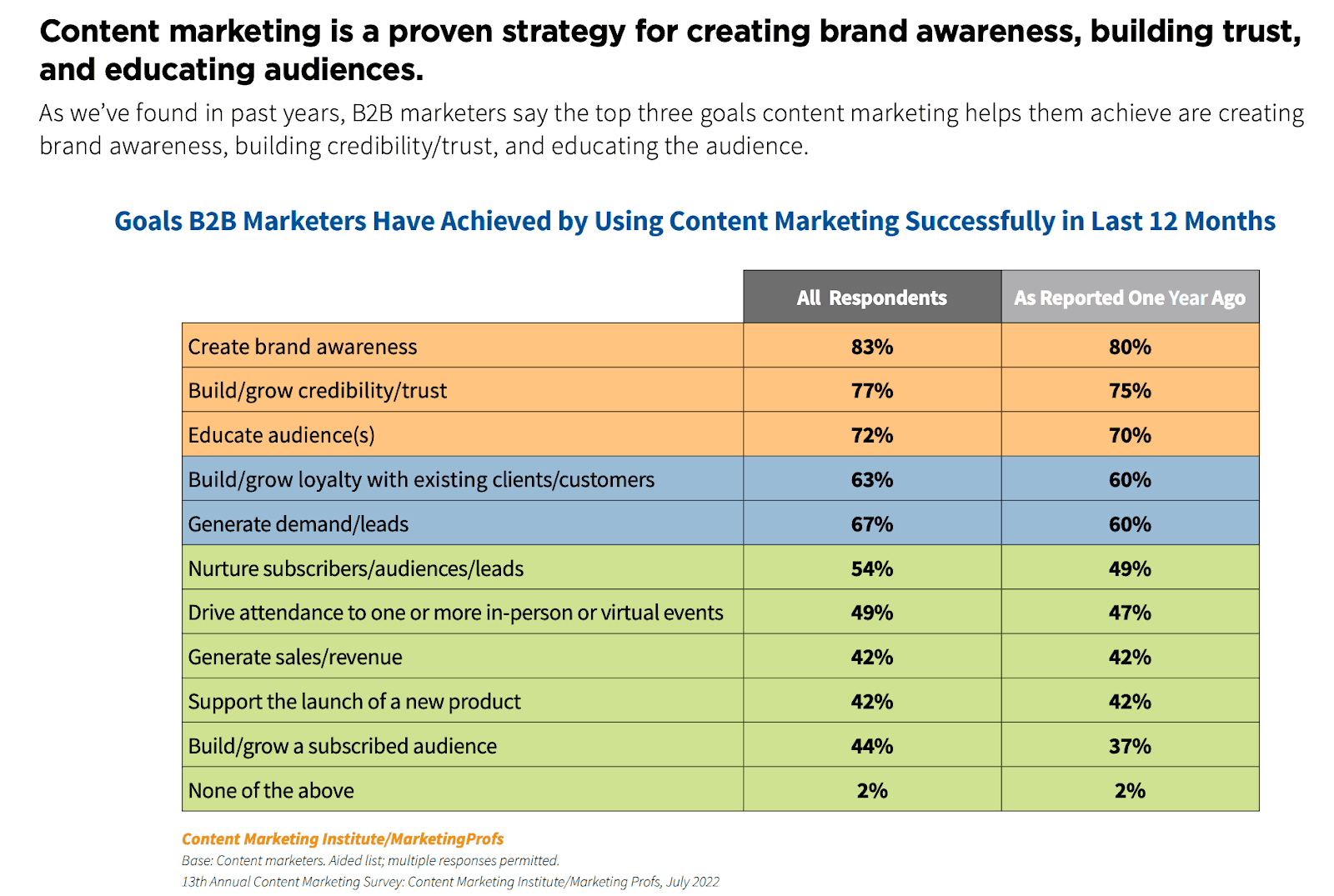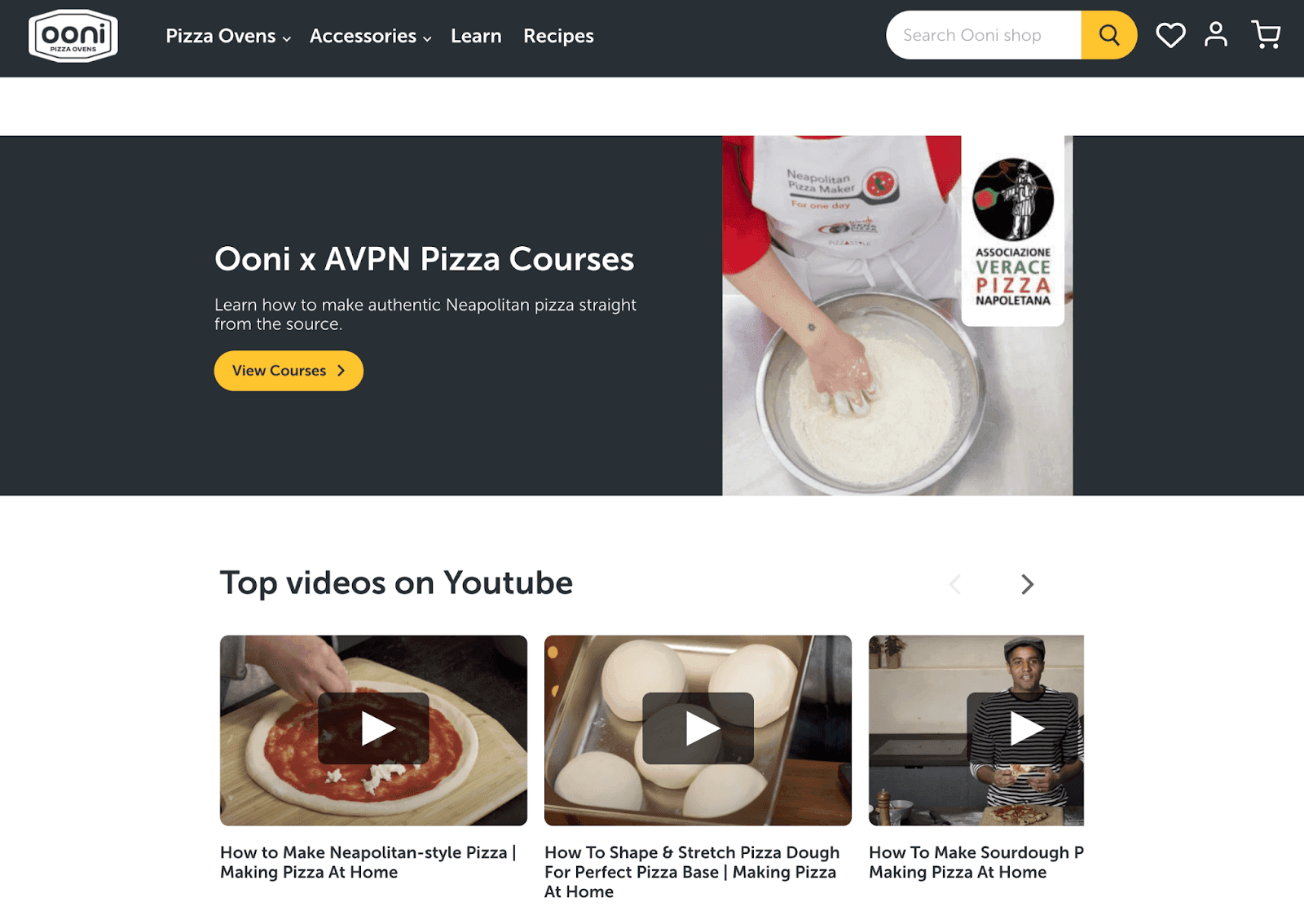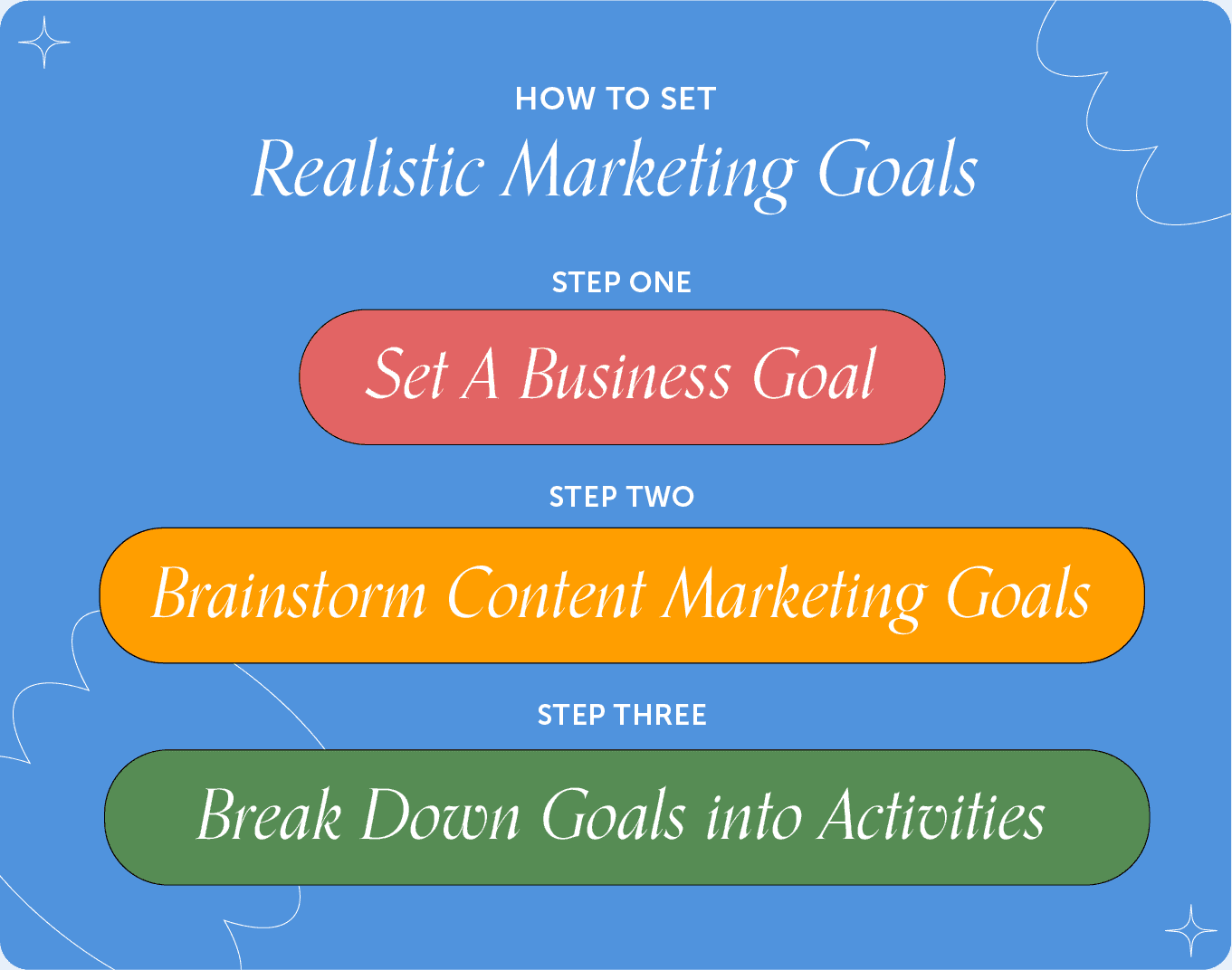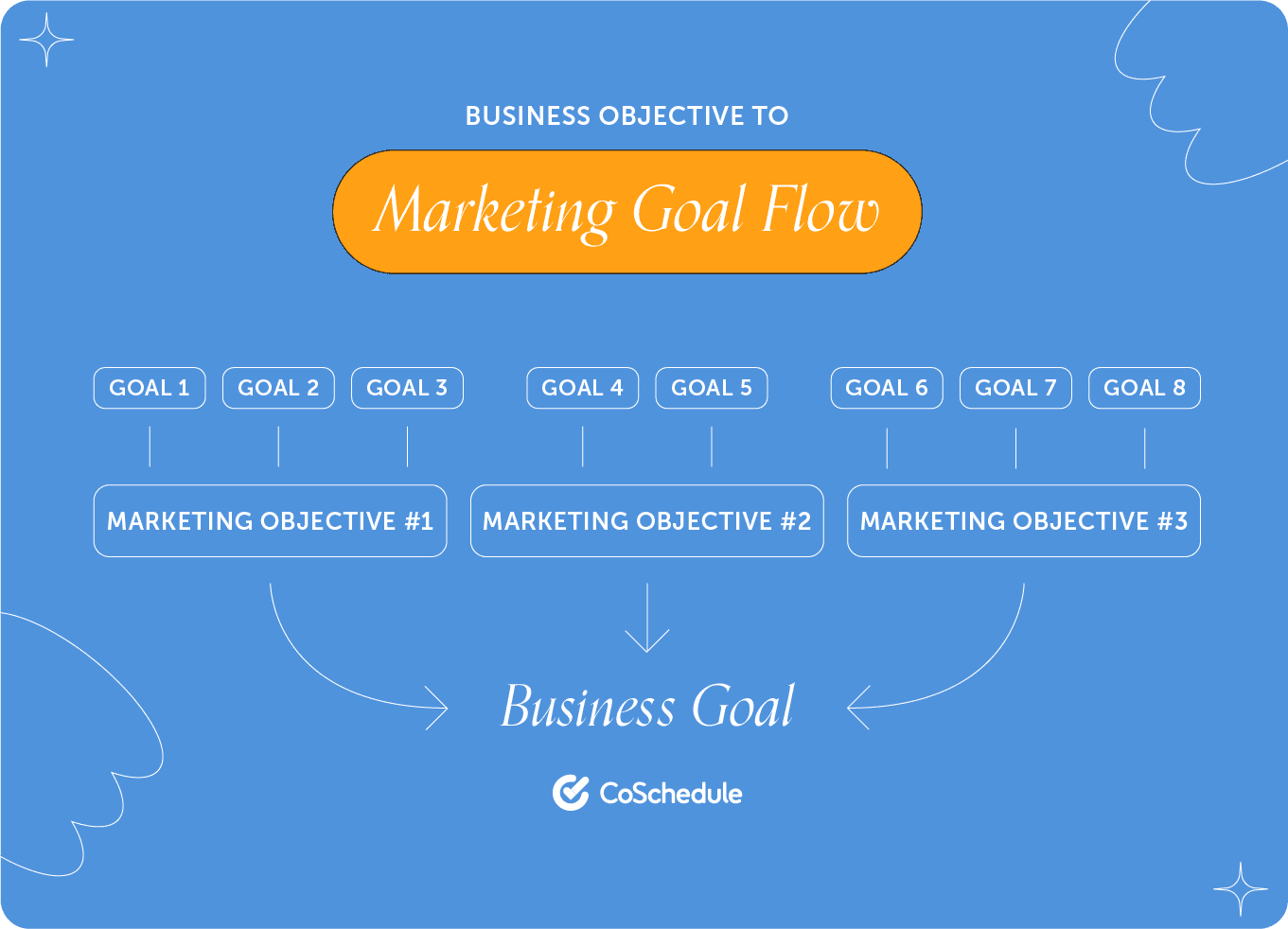Content marketing goals are essential for every thriving marketing team and thousands of successful businesses.
Without them, you can create valuable content and still not drive profitable customer action. If you want to make sure you never waste a minute of your time and a dollar of your budget on pointless activities, this guide is for you.
You’ll learn:
- Why content marketing goals are crucial to your business
- 7 examples of common content marketing goals
- How to set realistic goals for your content marketing
- How to measure your content marketing success
What Are Content Marketing Goals?
Content marketing goals allow you to track the efficiency of your content creation and promotion and its impact on the broader business results. Content marketing goals are how you can measure the success of your content marketing strategy.
Setting and tracking goals is as important in content marketing as it is in life: our research shows that marketers who set goals are 377% more likely to report success than those who don’t.
Content is often seen as the creative but fluffy and vague part of marketing, so measuring it—and hitting goals with it—can seem futile. Parse.ly’s Content Matters 2022 report revealed that 53% organizations don’t tie their revenue goals to content. The same report shows advertising placements and sponsored content as the leading ways that content drives revenue.
That’s no surprise—Content Marketing Institute reported that 70% of marketers rely on conversions as the leading metric to measure their content performance.
But content does so much more for your brand than just driving direct conversions. It’s a piece of a larger marketing puzzle, along with marketing strategies, tactics, channels, and collateral—all of which work together to drive brand awareness, reach potential customers, win new customers, retain existing ones, and foster brand loyalty.

That’s why setting a range of content marketing goals can level up your entire content process, from building an audience to supporting sales teams and beyond.
What Are The Common Content Marketing Goals?
Quality content is a powerful asset across the entire marketing funnel, from reaching a new audience and growing overall awareness of your brand to generating leads, making sales, and driving loyalty.
The 2023 B2B Content Marketing Benchmarks report shows that brand awareness, credibility and trust, and audience education are the top three goals content marketers achieve.

Let’s explore the most common content marketing goals you can consider for your business:
1. Brand Awareness
Think about a few industries and the companies that come to mind within each of them.
For example, the fitness industry might bring up Gymshark. When it comes to ecommerce tech, Shopify is the name of the game. Kylie Cosmetics reigns the makeup world. Even if you’ve never bought from these brands, you’re likely well aware of them.
Whatever brand you think of, there’s a reason for that: it has intentionally deployed marketing strategies and created consistent content in order to make as many people as possible know their name and what they do.
Diverse social media strategies, influencer partnerships, public relations efforts, and educating visitors through long-form content are just a few ways brands work on building brand awareness in the digital world.
2. Subscribers
One of the best ways to measure the actual size of your audience is to count the people that deliberately subscribed to hear from you regularly.
Email subscribers are often the easiest metric to measure and are usually the most common way to do this. Beyond the number of subscribers, you can also track which emails they open and the links they click on. In addition to email subscribers, you can also aim to grow podcast subscribers, free community members (for example, people who joined your Facebook group), and YouTube subscribers.
The episode How To Set Content Marketing Goals That Matter To Business Leaders by the ALEPH podcast summed it up well:
Building a subscribed audience is the basis of content marketing. Subscribers give you permission to communicate with them regularly. And that gives you permission to subtly market to them while giving them value outside of your company’s products or services. The business asset created by content marketing isn’t content. It’s the audience.
– the ALEPH podcast
3. Leads
Lead generation is one of the direct ways your content marketing efforts support your sales team or revenue.
That’s because a lead is someone who has shown explicit interest in your product or service: they signed up for a free trial, submitted a product demo request, ordered samples of your product, or got close to completing their order.
Once you track your leads and actively work on growing them, lead nurturing also becomes a meaningful piece of the puzzle.
4. Sales & Revenue
Dedicated sales enablement content can drive profitable actions from customers: case studies, testimonials, customer interviews, product demo videos, and user-generated content are just a few examples.
This can be harder to track than almost every other content marketing goal.
The CMI report mentioned earlier uncovered that integrating and correlating data across multiple platforms is the leading challenge for B2B marketers when measuring content performance. On top of that, 74% of marketing teams report that their workflow is siloed and has disconnected processes according to Airtable’s 2022 Marketing Trends report.
More often than not, the content marketing journey plays a big role in winning new customers.
5. Retention & Customer Loyalty
Customer retention—getting existing customers to trust you again and again—is one of the key elements of a healthy business.
Content marketing can foster brand loyalty and customer retention by onboarding and educating customers through blog posts, in-depth product guides, and other valuable content that makes them feel seen, heard, and understood throughout their journey with you.
If you want a fantastic example of a company that builds great content for their current customers, look no further than the oven pizza company Ooni.

6. Brand Authority
Brand authority is the level at which your business becomes the go-to trusted resource for your industry. You’re not just known through your brand awareness efforts—you’re also the leader.
The way to work towards this goal is through thought leadership content, strategic industry co-marketing efforts, and guest appearances on podcasts, interviews, and panels. This way, you can showcase your unique point of view to your target audience and beyond, and leverage that momentum to further expand your reach, win press mentions, and grow brand loyalty.
7. SEO Presence
Search engine optimization (SEO) can play a role in the above content marketing goals if you succeed in highly ranking dedicated content in search engines’ results.
A strong SEO presence means you can attract targeted traffic towards the relevant content assets and support the goals they were built for—and do so in the long run and (almost) on autopilot.
Oftentimes SEOs get caught in the trap that it is a long game, right? Like, ‘SEO takes a long time for it to work. You’ve gotta wait months and years.’ That is a fundamental falsehood. There is nothing true about SEO taking a long time. The only reality is that you’re not defining the short-term measurements that are going to lead to the long-term results.
– Jordan Koene, SEO advisor and strategist on the Voices of Search podcast
Not just that: your brand can become the first brand people think of when searching for the type of product you sell. Brands like Nike, NVGTN, and AYBL have done exactly that when it comes to gym leggings for women:

Suggestions that come up when searched on Google.
How Content Marketing Supports Business Goals
Business goals are like the destination of a trip; they make every step of the journey clearer and easier to follow. They keep all teams—developers, designers, marketers, operations, leadership, everyone—on the same page and working towards the same outcomes.
According to a report by Contently, only two-thirds of marketers reported that their head of marketing fully understands and supports the goals of their content marketing program.
Some examples of business goals include:
- Increase monthly revenue by X%
- Expand market share by X%
- Increase the number of customers by X
- Increase retention rate by X%
- Improve customer satisfaction score (CSAT) by X points
Without setting content marketing goals, you might end up creating content that doesn’t contribute to any of these business goals. That doesn’t mean it isn’t high quality content, but the hours invested into it can go to waste if there are no content goals to guide them.
For example, if the company’s main goal for the year is to increase customer retention rate by 5%, but all you’re producing is top-of-the-funnel content, your work isn’t helping your company generate repeat business.
Airtable’s research shows that 81% of marketing teams are responsible for contributing to revenue goals, but less than a third have visibility into the ROI their campaigns produced. This is why breaking down silos between teams is essential.
How To Set Realistic Goals for Content Marketing
To define content marketing goals, you need to start from your business goals and work backwards.
This will allow you to reverse-engineer your way to a content strategy and activities in it that will maximize your chance of hitting a content goal and your company’s business goal.

Step 1: Select A Business Goal
For this step, you need to collaborate with other teams and leaders in your company.
This will be driven by your company’s strategy, and there will likely be multiple business goals to work towards, but to break down this process, start with one—you can always add more as you get familiar and comfortable with this process.
Example of a business goal: win 300 new customers in Q3 (a 20% increase from 250 in Q2)
Step 2: Brainstorm Content Marketing Goals
Take your business goal and list out all the ways a content strategy contributes to the number of new customers you win each quarter. For example:
- More traffic increases the number of people who subscribe to your email list
- More people on your email list increase the number of visits to your bottom-of-the-funnel content
- Lead nurturing can increase the conversion rate of your emails
- Lead nurturing makes leads more ready to buy once they speak to a sales rep
- Publishing original research and unique infographics help with link building and press mentions, which increases traffic to your blog and product pages
As you can see, there are many ways to build a marketing strategy from your business goals. Select a few you believe will make the most impact based on previous results.
Examples of content marketing goals:
- Goal 1: Increase traffic to top- and middle-of-the-funnel blog posts by 20%
- Goal 2: Increase open rates on lead-nurturing emails by 10%
- Goal 3: Build 50 new backlinks from reputable media and industry websites
Step 3: Break Down Content Marketing Goals Into Activities
Finally, break down your content marketing objectives into activities that will get you as close as possible to reaching them.
Get creative here and involve your team in this process because there are many ways to reach these goals—you’re looking for those that will help you stand out to your target audience and get them to stick around.
Having this list of activities will also help you measure your efforts; more on that in the next section.
Examples of activities that support content marketing goals:
Goal 1: Increase traffic to top- and middle-of-the-funnel blog posts by 20%
- Review blog posts that dropped in search rankings in the past six months and use content optimization tools and processes to update them
- Collaborate with three to five non-competing companies in your industry on a joint webinar or blog post series to reach their audience and drive them to your blog
- Choose 30 blog posts to turn into bite-sized Twitter threads and LinkedIn posts and share them in specified time slots during the week, up to three different posts per week
- Develop an employee advocacy program to encourage employees who are active on social media to share blog posts with their respective audiences
Goal 2: Increase open rates on lead-nurturing emails by 10%
- Split-test different formats of email subject lines
- Experiment with different options for the sender name in the educational email series
- Run experiments with more or fewer emails after a new email subscriber joins your email list
Goal 3: Build 50 new backlinks from reputable media and industry websites
- Turn the most popular guides into engaging content formats like a series of shareable graphics
- Analyze original data from your customers to turn them into shareable statistics
- Respond to 10 journalist requests per week through services like HARO and Help a B2B Writer
- Pitch your CEO or another relevant leader in your company to write a thought leadership guest article for an industry publication

How To Measure Content Marketing Goals
The only way to know you’re on the way to hitting your content marketing goals is through content marketing metrics.
The work you’ve done to develop your goals and activities will drive the metrics you track, and you can look at them through two lenses:
- Leading indicators: the metrics that track the work you’re actively doing; e.g. the number of journalist requests you’ve responded to, the number of existing blog posts you’ve updated
- Lagging indicators: the metrics that show results of the work you’ve done in the past; e.g. the number of backlinks you’ve built by responding to journalists, the traffic increase from updating blog posts
For each goal you’ve set and the corresponding activity you’ve mapped to it, list leading and lagging metrics you will track to understand your progress.
Bring these reports to your content team and to other team leads you meet with on a regular basis—this will create a sense of transparency, collaboration, and alignment towards the big, important business objectives and goals your company is pursuing.

